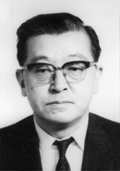Kaoru Ishikawa
| Kaoru Ishikawa |
|---|
| See also |
Kaoru Ishikawa (1915-1989) was one of the most influential people in quality movement after World War II. The translated and adjusted to Japanese culture management concepts of William Edwards Deming and Joseph M. Juran. He is known mainly for implementation of quality circles and Fish diagram.
Biography
- 1939 - engineering degree in applied chemistry at the University of Tokyo
- 1939-41 - technical officer in Navy
- 1941-47 - Nissan Liquid Fuel Company
- 1947 - professor at University of Tokyo
- 1949 - joins Japanese Union of Scientists and Engineers (JUSE)
- 1962 - concept of quality circles
- 1978 - president of Musashi Institute of Technology
- 1982 - development of Ishikawa chart
Contributions
Kaoru ishikawa contributed to the quality philosophy i.e.:
- implementation of quality circles,
- Ishikawa chart (Fishbone cause and effect diagram)
- user friendly quality control
- emphasised the internal customer
Quality circles
A quality circle is a group of workers that meet regularly in order to analyse and solve work-related problems. The team works independently, however under supervision of managers. Quality circles use Kaizen philosophy to improve work, process and product. The idea is widespread in Japan, however it encountered significant problems in Western culture countries. The individualism and short-term orientation limit the use of quality circles in Europe or USA.
Ishikawa chart
Fish diagram is a cause and effect diagram, which shows causes of specific event (problem). The chart allows deep analysis of causes. The main construction rule is asking Why? question. According to Genichi Taguchi, the level of analysis should be 5 levels deep. The chart is used worldwide to solve different problems.
References
- Ishikawa K. (1985) What is Total Quality Control?. Prentice-Hall Inc., Englewood Cliffs, New Jersey: Prentice Hall
- Ishikawa K (1980) QC Circle Koryo : General Principles of the QC Circle. Tokyo: QC Circle Headquarters, Union of Japanese Scientists and Engineers.
- Marks, M.L., Mirvis, P.H., Hackett, E.J., Grady, J.F., (1986) Employee participation in a Quality Circle program: Impact on quality of work life, productivity, and absenteeism, Journal of Applied Psychology, Vol 71(1)
- Barrick M.R., Alexander R.A. (1987), A review of quality circle efficacy ant the existence of positive-findings bias, Personnel psychology, 40(3)
Author: Slawomir Wawak
